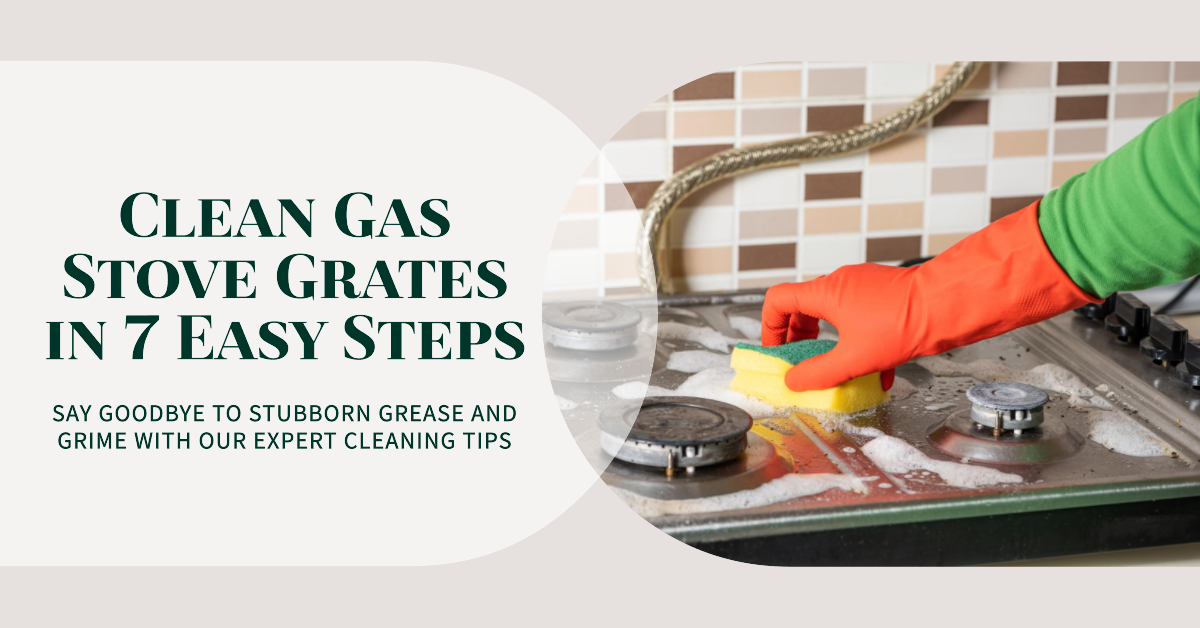Gas stoves have become a staple in modern kitchens due to their precise temperature control and efficiency. However, regular use can lead to the accumulation of grease, food residue, and stubborn stains on the gas stove grates.
These unsightly grime deposits not only affect the appearance of your stove but can also hinder its performance.
In this comprehensive guide, we will walk you through a step-by-step process of cleaning gas stove grates, providing you with practical tips and expert techniques to restore them to their sparkling clean state.
How to Clean Gas Stove Grates: A Step-by-Step Guide
Before you start the cleaning process, gather the following materials:
- Dish soap or mild detergent: Choose a gentle, non-abrasive soap to avoid damaging the grates. Look for formulas that are effective in cutting through grease and grime.
- Baking soda: An effective natural abrasive that helps lift stubborn stains without scratching the surface. It’s also safe to use on various types of grates, including cast iron and stainless steel.
- White vinegar: A natural degreaser and stain remover that works wonders on stuck-on residue. The acidic properties of vinegar help break down grease and grime, making it easier to clean.
- A scrub brush or sponge: Select a brush or sponge with medium to firm bristles to tackle tough stains. The scrub brush should be able to reach into the grates’ crevices and corners.
- Ziplock bags (large enough to fit the grates): These will be used for soaking the grates. Make sure they are sturdy and sealable to prevent leaks.
- Rubber gloves: Protect your hands from harsh chemicals and hot water during the cleaning process.
Step 1: Safety First
Safety is paramount when cleaning gas stove grates. Before you begin, ensure your gas stove is turned off and has cooled down completely. This will prevent any accidental gas leaks or burns during the cleaning process.
Step 2: Remove the Grates
Carefully lift the grates from your gas stove. In some cases, they may be held in place by small clips or hooks. If the grates are stuck, gently wiggle them to release any residue buildup that may be holding them in place. Once removed, place them on a protected surface, such as a large towel or newspaper, to catch any drips.
Step 3: Soak in Hot, Soapy Water
Fill your kitchen sink or a large basin with hot water and add a few drops of dish soap or mild detergent. Submerge the grates in the soapy water and let them soak for at least 15 to 30 minutes. This soaking process will help loosen the grime and soften stubborn stains, making it easier to clean later.
Step 4: Scrubbing the Grates
After the soaking time, put on your rubber gloves and take one of the grates out of the water. Use a scrub brush or sponge to gently scrub away the loosened dirt and grease. For tougher stains or burnt-on residue, sprinkle some baking soda on the grates and scrub with a bit more force. Baking soda’s natural abrasive properties will help lift stubborn stains without damaging the surface.
a. For Cast Iron Grates:
Cast iron grates require special care to maintain their seasoning. Avoid using harsh chemicals or metal scouring pads, as they can strip the seasoning layer. Instead, focus on gentle scrubbing using only a soft brush or sponge. After cleaning, make sure to dry the cast iron grates thoroughly to prevent rust.
b. For Stainless Steel Grates:
Stainless steel grates can handle a bit more scrubbing power. You can use a slightly firmer brush or sponge to tackle tough stains. Stainless steel is resistant to rust, but it’s still essential to dry the grates thoroughly to prevent water spots or stains.
Step 5: Vinegar Solution for Stuck-On Residue
If you still notice some stubborn residue after scrubbing, create a vinegar solution by mixing equal parts white vinegar and water. Fill a spray bottle with the solution and apply it to the affected areas on the grates. Let it sit for a few minutes to break down the grime further. The acidic nature of vinegar makes it an excellent natural degreaser and stain remover. After the vinegar has had time to work its magic, scrub the grates again with your brush or sponge.
Step 6: Rinse Thoroughly
Once you have scrubbed the grates clean, rinse them thoroughly with running water to remove any remaining soap, baking soda, or vinegar solution. Ensure there are no traces of cleaning agents left on the grates, as these could affect the taste of your food when you cook next.
Step 7: Drying and Reinstallation
Pat dry the grates with a clean towel or let them air dry completely. It’s essential to ensure they are thoroughly dry before reinstalling them on your gas stove to prevent any rusting. Once dry, place the grates back on your gas stove, ensuring they are correctly aligned and secure.
Three Additional Tips for a Better Cleaning Output
a. Regular Maintenance:
Prevention is always better than cure. To minimize the effort needed for deep cleaning, make it a habit to wipe down your gas stove grates after each use. This practice will prevent excessive buildup of grime and make the cleaning process much more manageable.
b. Cleaning Tough Stains:
For particularly tough stains or carbon deposits, you can use a commercial stove cleaner designed explicitly for grates. Follow the manufacturer’s instructions carefully, as some cleaners may require specific application methods.
c. Dishwasher-Safe Grates:
Check the manufacturer’s instructions to determine if your gas stove grates are dishwasher-safe. If they are, you can place them in the dishwasher for a hassle-free and effective cleaning experience. However, handwashing is generally recommended to avoid potential damage caused by dishwasher cycles.
Final Words
Cleaning gas stove grates is a simple but essential task that should be a part of your regular kitchen maintenance routine. By following this comprehensive step-by-step guide and utilizing readily available household items, you can effectively remove grime and stubborn stains from your gas stove grates.
Not only will this restore their shine and appearance, but it will also maintain your gas stove’s efficiency and ensure a safe and hygienic cooking environment for you and your family.
Remember, regular cleaning and maintenance will not only prolong the life of your gas stove but also enhance your cooking experience. So, roll up your sleeves, follow our expert tips, and keep your gas stove grates sparkling clean!

